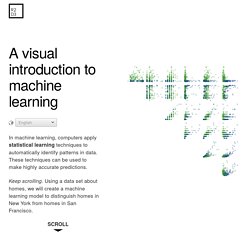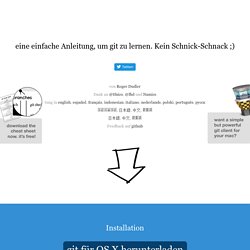

A Visual Introduction to Machine Learning. Finding better boundaries Let's revisit the 73-m elevation boundary proposed previously to see how we can improve upon our intuition.

Clearly, this requires a different perspective. By transforming our visualization into a histogram, we can better see how frequently homes appear at each elevation. While the highest home in New York is 73m, the majority of them seem to have far lower elevations. Your first fork A decision tree uses if-then statements to define patterns in data. For example, if a home's elevation is above some number, then the home is probably in San Francisco. In machine learning, these statements are called forks, and they split the data into two branches based on some value. That value between the branches is called a split point. Tradeoffs Picking a split point has tradeoffs. Look at that large slice of green in the left pie chart, those are all the San Francisco homes that are misclassified. The best split Recursion. Syrian Journey: Choose your own escape route.
The Syrian conflict has torn the country apart, leaving thousands dead and driving millions to flee their homes. Many seek refuge in neighbouring countries but others pay traffickers to take them to Europe - risking death, capture and deportation. If you were fleeing Syria for Europe, what choices would you make for you and your family? Take our journey to understand the real dilemmas the refugees face.
The routes, options and outcomes in this Syrian Journey feature were based on real stories uncovered by extensive research as part of a BBC Arabic digital project exploring migration from Syria. Research by Mamdouh Akbiek, Eloise Dicker Illustrations by Gerry Fletcher. Get involved We would like to know what you would take with you if you were forced to flee your country. Use the hashtags #whatwouldyoutake and #Syrianjourney to post your choices, with images and/or video. See what Syrian migrants who made the journey took with them Survivors' stories Media playback is unsupported on your device.
Paul Ford: What is Code? A computer is a clock with benefits.

They all work the same, doing second-grade math, one step at a time: Tick, take a number and put it in box one. Tick, take another number, put it in box two. Tick, operate (an operation might be addition or subtraction) on those two numbers and put the resulting number in box one. Tick, check if the result is zero, and if it is, go to some other box and follow a new set of instructions. You, using a pen and paper, can do anything a computer can; you just can’t do those things billions of times per second. Apple has always made computers; Microsoft used to make only software (and occasional accessory hardware, such as mice and keyboards), but now it’s in the hardware business, with Xbox game consoles, Surface tablets, and Lumia phones. So many things are computers, or will be. When you “batch” process a thousand images in Photoshop or sum numbers in Excel, you’re programming, at least a little. 2.1 How Do You Type an “A”?
Git - Der einfache Einstieg - kein Schnick-schnack! Git - Der einfache Einstieg eine einfache Anleitung, um git zu lernen.

Kein Schnick-Schnack ;) von Roger Dudler Dank an @tfnico, @fhd und Namics diese Anleitung in english, español, français, indonesian, italiano, nederlands, polski, português, русский, türkçe, မြန်မာ, 日本語, 中文, 한국어 日本語, 中文, 한국어 Feedback auf github Installation git für OS X herunterladen git für Windows herunterladen git für Linux herunterladen Neues Repository erstellen erstelle ein neues Verzeichnis, öffne es und führe git init aus, um ein neues git-Repository anzulegen.
Ein Repository auschecken erstelle eine Arbeitskopie, indem du folgenden Befehl ausführst: git clone /pfad/zum/repository Falls du ein entferntes Repository verwendest, benutze: git clone benutzername@host:/pfad/zum/repository Workflow Dein lokales Repository besteht aus drei "Instanzen", die von git verwaltet werden. Add & commit Änderungen hochladen Die Änderungen sind jetzt im HEAD deines lokalen Repositories. Branching update & merge Tagging Nützliche Tricks. Umfrage zu Flüchtlingen: «Wir wissen nicht, was anfangen mit diesen Leuten» 2.7.2015, 05:01 Uhr «Wir wissen nicht, was anfangen mit diesen Leuten» Facebook Twitter Email Laut aktuellen Studien ist der Asylbereich eines der dringendsten Probleme in der Schweiz.
